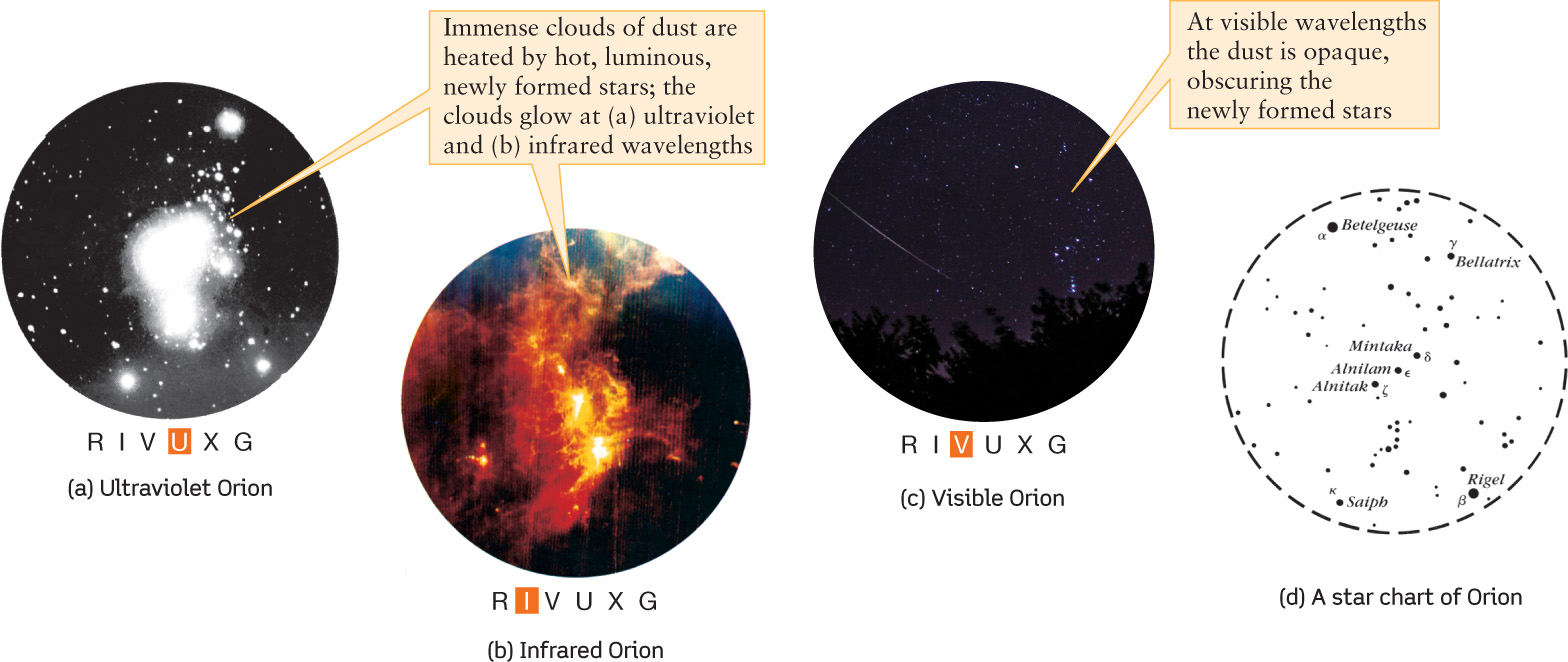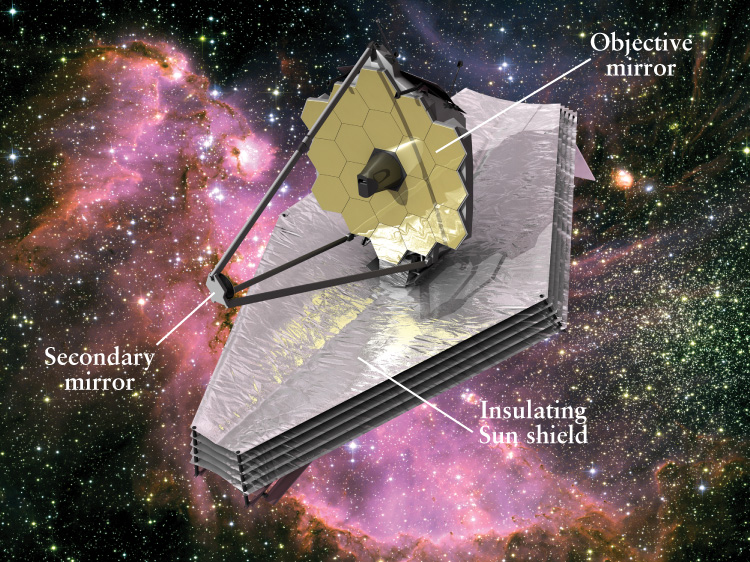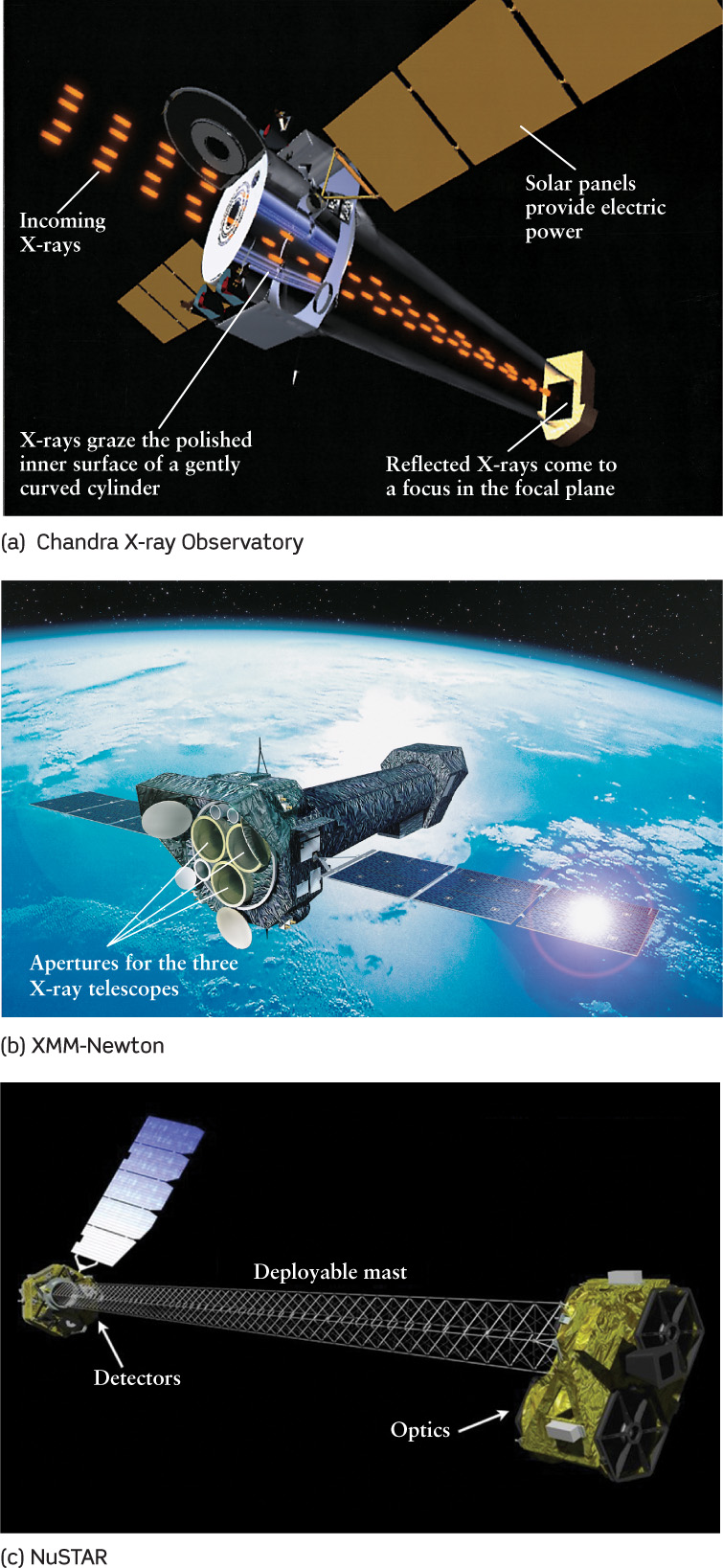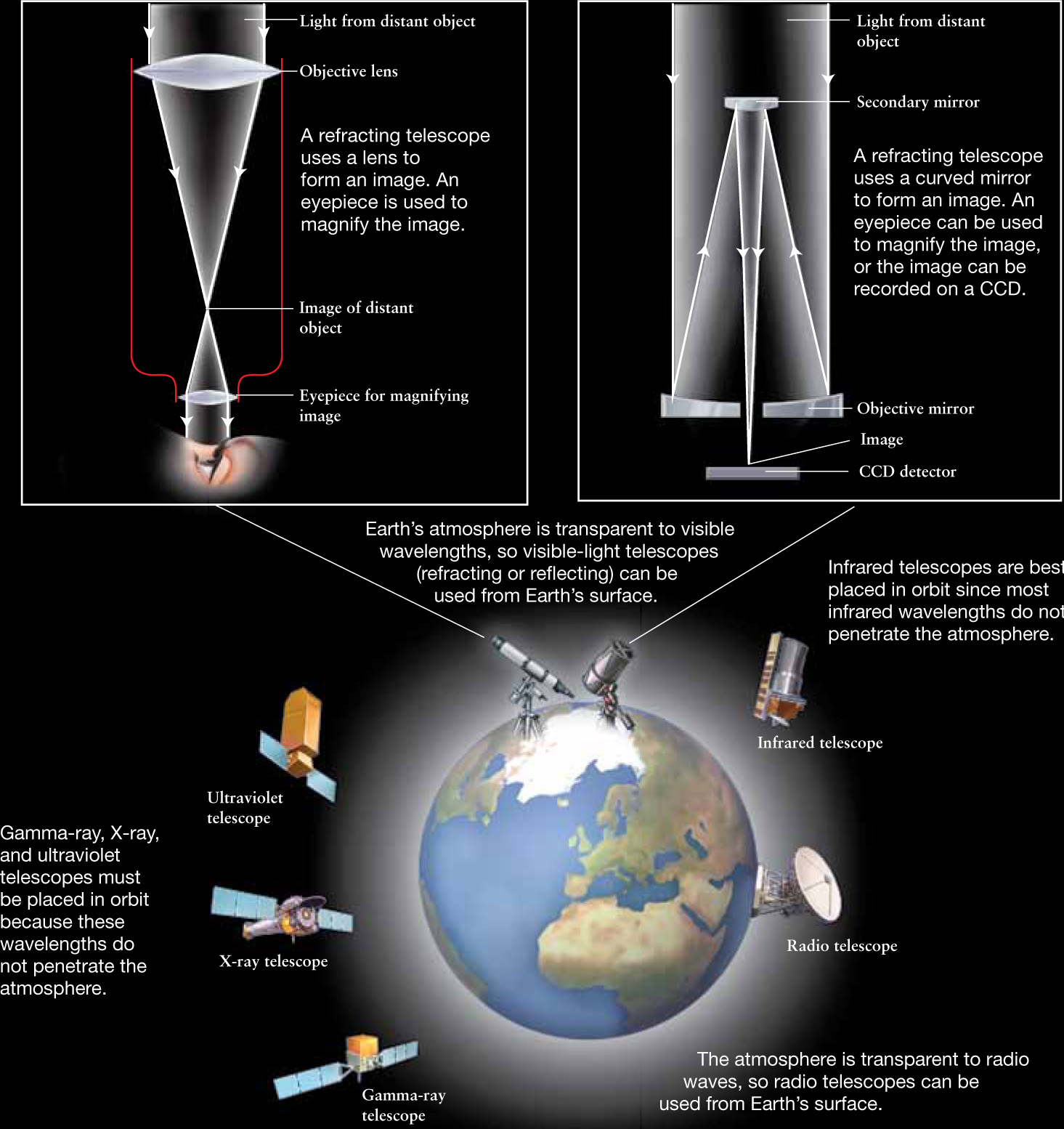6-7 Telescopes in orbit around Earth detect radiation that does not penetrate the atmosphere
Space telescopes make it possible to study the universe across the entire electromagnetic spectrum
 The many successes of radio astronomy show the value of observations at nonvisible wavelengths. But Earth’s atmosphere is opaque to many wavelengths. Other than visible light and radio waves, very little radiation from space manages to penetrate the air we breathe. To overcome this, astronomers have placed a variety of telescopes in orbit around the planet.
The many successes of radio astronomy show the value of observations at nonvisible wavelengths. But Earth’s atmosphere is opaque to many wavelengths. Other than visible light and radio waves, very little radiation from space manages to penetrate the air we breathe. To overcome this, astronomers have placed a variety of telescopes in orbit around the planet.
Figure 6-25 shows the transparency of Earth’s atmosphere to different wavelengths of electromagnetic radiation. The atmosphere is most transparent in two wavelength regions, the optical window (which includes the entire visible spectrum) and the radio window (which includes part, but not all, of the radio spectrum). There are also several relatively transparent regions at infrared wavelengths between 1 and 40 μm. Infrared radiation within these wavelength intervals can penetrate Earth’s atmosphere somewhat and can be detected with ground-based telescopes. This wavelength range is called the near-infrared, because it lies just beyond the red end of the visible spectrum.

CONCEPT CHECK 6-10
Look at Figure 6-25, which shows the transparency of Earth’s atmosphere. Would astronomers most prefer to have a new ground-based telescope constructed that is most sensitive in the X-ray region, the ultraviolet wavelength region, or in the microwave region?
Given these three choices, astronomers would much prefer to have a new telescope in the microwave region because X-rays and ultraviolet wavelengths rarely pass through Earth’s atmosphere to the ground. While the atmosphere absorbs some portion of microwaves, not all microwaves are absorbed.
Infrared Astronomy
Water vapor is the main absorber of infrared radiation from space, which is why infrared observatories are located at sites with exceptionally low humidity. The site must also be at high altitude to get above as much of the atmosphere’s water vapor as possible. One site that meets both criteria is the summit of Mauna Kea in Hawaii, shown in Figure 6-16. (The complete lack of vegetation on the summit attests to its extreme dryness.) Some of the telescopes on Mauna Kea are designed exclusively for detecting infrared radiation. Others, such as the Keck I and Keck II telescopes, are used for both visible and near-infrared observations (see Figure 6-18).

Even at the elevation of Mauna Kea, water vapor in the atmosphere restricts the kinds of infrared observations that astronomers can make. This situation can be improved by carrying telescopes on board high-altitude balloons or aircraft. But the ultimate solution is to place a telescope in Earth’s orbit and radio its data back to astronomers on the ground. The first such orbiting infrared observatory, the Infrared Astronomical Satellite (IRAS), was launched in 1983. During its nine-month mission, IRAS used its 57-cm (22-in.) telescope to map almost the entire sky at wavelengths from 12 to 100 μm.
The IRAS data revealed the presence of dust disks around nearby stars. Planets are thought to coalesce from disks of this kind, so this was the first observational indication that there might be planets orbiting other stars. The dust that IRAS detected is warm enough to emit infrared radiation but too cold to emit much visible light, so it remained undetected by ordinary optical telescopes. IRAS also discovered distant, ultraluminous galaxies that emit almost all their radiation at infrared wavelengths.
In 1995 the Infrared Space Observatory (ISO), a more advanced 60-cm reflector with better light detectors, was launched into orbit by the European Space Agency. During its two-and-one-half-year mission, ISO made a number of groundbreaking observations of very distant galaxies and of the thin, cold material between the stars of our own Galaxy. Like IRAS, ISO had to be cooled by liquid helium to temperatures just a few degrees above absolute zero. Had this not been done, the infrared blackbody radiation from the telescope itself would have outshone the infrared radiation from astronomical objects. The ISO mission came to an end when the last of the helium evaporated into space.
At the time of this writing the largest orbiting infrared observatory is the Herschel Space Observatory, a 3.5-m infrared telescope designed to survey the infrared sky with unprecedented resolution (Figure 6-26). Placed in orbit in 2009, the Herschel Space Observatory is being used to study galaxy formation in the early universe, star formation, and the chemical composition of atmospheres around planets, moons, and comets in our solar system.
Ultraviolet Astronomy
Astronomers are also very interested in observing at ultraviolet wavelengths. These observations can reveal a great deal about hot stars, ionized clouds of gas between the stars, and the Sun’s high-temperature corona (see Section 3-5), all of which emit copious amounts of ultraviolet light. The spectrum of ultraviolet sunlight reflected from a planet can also reveal the composition of the planet’s atmosphere. However, Earth’s atmosphere is opaque to ultraviolet light except for the narrow near-ultraviolet range, which extends from about 400 nm (the violet end of the visible spectrum) down to 300 nm.
To see shorter-wavelength far-ultraviolet light, astronomers must again make their observations from space. The first ultraviolet telescope was placed in orbit in 1962, and several others have since followed it into space. Small rockets have also lifted ultraviolet cameras briefly above Earth’s atmosphere. Figure 6-27 shows an ultraviolet view of the constellation Orion, along with infrared and visible views.

The Far Ultraviolet Spectroscopic Explorer (FUSE), which went into orbit in 1999 and remained until 2007, specialized in measuring spectra at wavelengths from 90 to 120 nm. Highly ionized oxygen atoms, which can exist only in an extremely high-temperature gas, have a characteristic spectral line in this range. By looking for this spectral line in various parts of the sky, FUSE confirmed that our Milky Way Galaxy (Section 1-4) is surrounded by an immense “halo” of gas at temperatures in excess of 200,000 K. Only an ultraviolet telescope could have detected this “halo,” which is thought to have been produced by exploding stars called supernovae (Section 1-3).
The Hubble Space Telescope
Infrared and ultraviolet satellites give excellent views of the heavens at selected wavelengths. But since the 1940s, astronomers had dreamed of having one large telescope that could be operated at any wavelength from the near-infrared through the visible range and out into the ultraviolet. This is the mission of the Hubble Space Telescope (HST), which was placed in a 600-km-high orbit by the space shuttle Discovery in 1990 (Figure 6-28). HST has a 2.4-m (7.9-ft) objective mirror and was designed to observe at wavelengths from 115 nm to 1 μm. Like most ground-based telescopes, HST uses a CCD to record images. (In fact, the development of HST helped drive advances in CCD technology.) The images are then radioed back to Earth in digital form.

The Hubble Space Telescope The largest telescope yet placed in orbit, HST is a joint project of NASA and the European Space Agency (ESA). HST has helped discover new moons of Pluto, probed the formation of stars, and found evidence that the universe is now expanding at a faster rate than several billion years ago. This photograph was taken from the space shuttle Discovery during a 1997 mission to service HST.
The great promise of HST was that from its vantage point high above the atmosphere, its angular resolution would be limited only by diffraction. But soon after HST was placed in orbit, astronomers discovered that a manufacturing error had caused the telescope’s objective mirror to suffer from spherical aberration. The mirror should have been able to concentrate 70% of a star’s light into an image with an angular diameter of 0.1 arcsec. Instead, only 20% of the light was focused into this small area. The remainder was smeared out over an area about 1 arcsec wide, giving images little better than those achieved at major ground-based observatories.
On an interim basis, astronomers used only the 20% of incoming starlight that was properly focused and, with computer processing, discarded the remaining poorly focused 80%. This was practical only for brighter objects on which astronomers could afford to waste light. But many of the observing projects scheduled for HST involved extremely dim galaxies and nebulae.
These problems were resolved by a second space shuttle mission in 1993. Astronauts installed a set of small secondary mirrors whose curvature exactly compensated for the error in curvature of the primary mirror. Once these were in place, HST was able to make truly sharp images of extremely faint objects. Astronomers have used the repaired HST to make discoveries about the nature of planets, the evolution of stars, the inner workings of galaxies, and the expansion of the universe. You will see many HST images in later chapters.
The success of HST has inspired plans for its larger successor, the James Webb Space Telescope, or JWST (Figure 6-29). Planned for a 2018 launch, JWST will observe at visible and infrared wavelengths from 600 nm to 28 μm. With its 6.5-m objective mirror—2.5 times the diameter of the HST objective mirror, with 6 times the light-gathering power—JWST will study faint objects such as planetary systems forming around other stars and galaxies near the limit of the observable universe. Unlike HST, which is in a relatively low-altitude orbit around Earth, JWST will orbit the Sun some 1.5 million km beyond Earth. In this orbit the telescope’s view will not be blocked by Earth. Furthermore, by remaining far from the radiant heat of Earth it will be easier to keep JWST at the very cold temperatures required by its infrared detectors.

 The James Webb Space Telescope (JWST) The successor to the Hubble Space Telescope, JWST will have an objective mirror 6.5 m (21 ft) in diameter. Like many Earthbound telescopes, JWST will be of Cassegrain design (see Figure 6-11b and Figure 6-14b). Rather than using liquid helium to keep the telescope and instruments at the low temperatures needed to observe at infrared wavelengths, JWST will keep cool using a multilayer sunshield the size of two tennis courts.
The James Webb Space Telescope (JWST) The successor to the Hubble Space Telescope, JWST will have an objective mirror 6.5 m (21 ft) in diameter. Like many Earthbound telescopes, JWST will be of Cassegrain design (see Figure 6-11b and Figure 6-14b). Rather than using liquid helium to keep the telescope and instruments at the low temperatures needed to observe at infrared wavelengths, JWST will keep cool using a multilayer sunshield the size of two tennis courts.
X-ray Astronomy
Space telescopes have also made it possible to explore objects whose temperatures reach the almost inconceivable values of 106 to 108 K. Atoms in such a high-temperature gas move so fast that when they collide, they emit X-ray photons of very high energy and very short wavelengths less than 10 nm. X-ray telescopes designed to detect these photons must be placed in orbit, because Earth’s atmosphere is totally opaque at these wavelengths.
CAUTION!
X-ray telescopes work on a very different principle from the X-ray devices used in medicine and dentistry. If you have your foot “X-rayed” to check for a broken bone, a piece of photographic film (or an electronic detector) sensitive to X-rays is placed under your foot and an X-ray beam is directed at your foot from above. The radiation penetrates through soft tissue but not as much through bone, so the bones cast an “X-ray shadow” on the film. A fracture will show as a break in the shadow. X-ray telescopes, by contrast, do not send beams of X-rays toward astronomical objects in an attempt to see inside them. Rather, these telescopes detect X-rays that the objects emit on their own.

Astronomers got their first quick look at the X-ray sky from brief rocket flights during the late 1940s. These observations confirmed that the Sun’s corona (see Section 3-5) is a source of X-rays, and must therefore be at a temperature of millions of kelvins. In 1962 a rocket experiment revealed that objects beyond the solar system also emit X-rays.
Since 1970, a series of increasingly sensitive and sophisticated X-ray observatories have been placed in orbit, including NASA’s Einstein Observatory, the European Space Agency’s Exosat, and the German-British-American ROSAT. These telescopes have shown that other stars also have high-temperature coronae and have found hot, X-ray–emitting gas clouds so immense that hundreds of galaxies fit inside them. They also discovered unusual stars that emit X-rays in erratic bursts. These bursts are now thought to be coming from heated gas swirling around a small but massive object—possibly a black hole.
X-ray astronomy took a quantum leap forward in 1999 with the launch of NASA’s Chandra X-ray Observatory and the European Space Agency’s XMM-Newton. Named for the Indian-American Nobel laureate astrophysicist Subrahmanyan Chandrasekhar, Chandra can view the X-ray sky with an angular resolution of 0.5 arcsec (Figure 6-30a). This is comparable to the best ground-based optical telescopes and more than a thousand times better than the resolution of the first orbiting X-ray telescope. Chandra can also measure X-ray spectra 100 times more precisely than any previous spacecraft and can detect variations in X-ray emissions on time scales as short as 16 microseconds. This latter capability is essential for understanding how X-ray bursts are produced around black holes.
XMM-Newton (for X-ray Multi-mirror Mission) is actually three X-ray telescopes that all point in the same direction (Figure 6-30b). Their combined light-gathering power is 5 times greater than that of Chandra, which makes XMM-Newton able to observe fainter objects. (For reasons of economy, the mirrors were not ground as precisely as those on Chandra, so the angular resolution of XMM-Newton is only about 6 arcseconds.) It also carries a small but highly capable telescope for ultraviolet and visible observations. Hot X-ray sources are usually accompanied by cooler material that radiates at these longer wavelengths, so XMM-Newton can observe these hot and cool regions simultaneously.
The latest X-ray telescope in space is NuSTAR, with an incredible 10-m long mast (Figure 6-30c). NuSTAR will search for enormous black holes, study particles moving at almost the speed of light, and analyze how atoms are produced during supernova explosions.
Gamma-Ray Astronomy

The Fermi Gamma-Ray Space Telescope This photograph shows the telescope placed inside half of the launching rocket’s nose cone. For scale: Several engineers in white clean-room gowns are at the base of the nose cone.
Gamma rays, the shortest-wavelength photons of all, help us to understand phenomena even more energetic than those that produce X-rays. As an example, when a massive star explodes into a supernova, it produces radioactive atomic nuclei that are strewn across interstellar space. Observing the gamma rays emitted by these nuclei helps astronomers understand the nature of supernova explosions.
Like X-rays, gamma rays do not penetrate Earth’s atmosphere, so space telescopes are required. One of the first gamma-ray telescopes placed in orbit was the Compton Gamma Ray Observatory (CGRO). One particularly important task for CGRO was the study of gamma-ray bursts, which are brief, unpredictable, and very intense flashes of gamma rays that are found in all parts of the sky. By analyzing data from CGRO and other orbiting observatories, astronomers have shown that the sources of these gamma-ray bursts are billions of light-years away. For these bursts to be visible across such great distances, their sources must be among the most energetic objects in the universe. By combining these gamma-ray observations with images made by optical telescopes, astronomers have found that at least some of the gamma-ray bursts emanate from stars that explode catastrophically. Launched in 2008, the Fermi Gamma-ray Space Telescope (Figure 6-31) continues the study of gamma-ray bursts and other highly energetic phenomena.
The Cosmic Connections figure shows the wavelengths at which Earth-orbiting telescopes are particularly useful, as well as summarizing the design of refracting and reflecting Earth-based telescopes. The advantages and benefits of Earth-orbiting observatories cannot be overemphasized. We are no longer limited to the narrow ranges of whatever wavelengths manage to leak through our shimmering, hazy atmosphere (Figure 6-32). For the first time, we are really seeing the universe.

CONCEPT CHECK 6-11
What is the primary advantage of an orbiting space telescope, compared to a ground-based telescope?
Orbiting space telescopes are placed far above most of Earth’s atmosphere. Without Earth’s atmosphere to absorb infrared, ultraviolet, X-ray, and gamma-ray light, astronomers can study the universe at these wavelengths.
COSMIC CONNECTIONS
Telescopes Across the EM Spectrum
Today, telescopes can view the universe in every range of electromagnetic radiation, although some must be above Earth’s atmosphere to receive radiation without interference.
